Dozens of people died in the suspended shaft
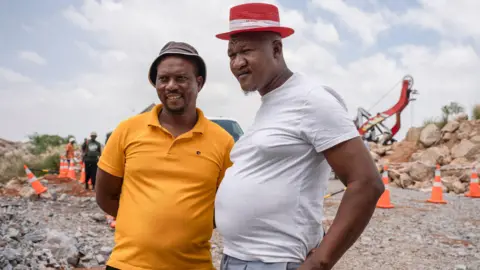 BBC
BBCWhen Mzwandile Mkwyi descends into the South African mine in a red metal cage attached to an above-ground hanger, the first thing that hits him is the smell.
“Let me tell you something,” he told the BBC, “these bodies smelled really bad.”
When he came home that day, he told his wife that he could not eat the meat he had cooked for her.
“Because when I talked to the miners, some of them told me they had to eat other (people) in the mine because there was no way they could get food. They were also eating cockroaches,” he said by phone. From his house.
Allegations that the miners resorted to cannibalism in order to survive were also brought to the court by the other miners who were rescued in December.
Mkwayi, an ex-convict known as Shasha, lives in the town of Kuma, near a used mine in Stilfontein. The 36-year-old, who spent seven years in prison for theft, volunteered to help with the rescue mission.
“I am being rehabilitated at the prison and I volunteered because people in our area need help for their children and siblings.
“The rescue organization said they didn’t have anyone who wanted to come down. So my friend Mandla and I agreed to volunteer to help our brothers pick up the bodies and take them out.”
But despite his desire to help, the 25-minute journey through the 2-kilometer (1.2-mile) deep trunk filled him with dread.
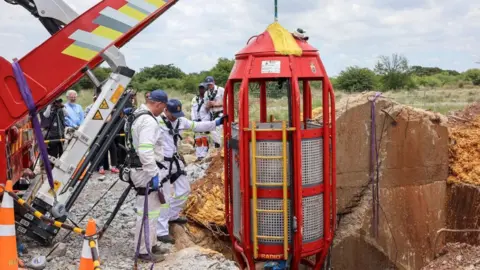 AFP
AFPThe crane occasionally stops and starts, leaving it hanging in the dark. Once inside the mine, he was shocked by what he saw.
“There were a lot of bodies, over 70 bodies and about 200 or so people who were dehydrated.
“When I saw them, I felt very weak, it was a sad thing to see. But Mandla and I decided that we had to be strong and show them how we felt so that we could inspire them.”
This story contains a video that some people find disturbing.
The miners, who had been waiting months for help, were given a hero’s welcome.
“They were very, very happy,” he says.
As the industry – once the backbone of the country’s economy – has declined, the miners have been stuck there following a nationwide police campaign to stop illegal mining in closed areas.
Working for Mining International was not profitable in many places, but the prospect of finding gold reserves was still a magnet for many desperate people – especially undocumented immigrants.
Thousands of rods were left.
In November, the police stepped up their efforts at the Buffelsfontein mine in Stilfontein, surrounding the entrance to the shaft and not allowing food and water down.
Before the rescue operation began on Monday, the local community tried to take matters into their own hands by lowering a rope from the bottom of the trunk and trying to pull out some people.
They also sent messages and told the miners that help was coming.
“So when we got there, they were waiting for the crane. Now when they see us, they see us as their president, as their messiahs. People who came from outside to help them get up in the pit.”
Police said the illegal miners could have always left on their own but were reluctant to do so for fear of arrest. But Mkwayi disagrees: “It’s a lie that people don’t want to leave. Those people were desperate for help, they were dying.”
While at the mine on Tuesday, the BBC saw dozens of survivors.
Their bones looked emaciated through their clothes. Some were unable to walk and had to be assisted by medical colleagues.
In their statements to the High Court, the illegal miners vividly describe the slow and painful death of their peers. Many say they starved to death.
“From September to October 2024, the absence of even basic food supplies was absolute and survival became a daily battle with hunger,” one miner recorded.
Mkwai said the people he rescued were so frail that the lifeboat, which was meant to hold seven healthy adults, could only take 13.
“They were so dry that they lost weight so we were able to get them into the cage because they wouldn’t survive in the hole for two days. If we don’t get them out as soon as possible, they will die.”
The volunteers were also removing the bodies.
“The rescue service gave us bags and told us to put the bodies inside and take them out into the hut, which we were assisted by some miners.”
The rescue operation was originally supposed to last at least a week, but after three days, no one was left underground, volunteers said.
Officials sent the camera down the shaft to do a final cleaning. They say the mine will now be permanently sealed.
But the experience affected Mkwai deeply.
At one point during the call he asked for the question to be repeated, stating that his hearing had been damaged after entering the mine, possibly due to the pressure.
But the most difficult effect is what he saw.
“I have to tell you, I’m very worried. I’ll never forget the sight of these people for the rest of my life.”
For community activists and unions, the deaths of 87 people at the mine were a “massacre” by the authorities.
The use of the word sensational has made a comparison with 34 striking miners were killed by police in Marikana150 km (93 mi) from Stilfontein, in 2012.
But this time no triggers were pulled. Instead, it seems that many people starved to death.
The authorities do not accept the idea that they are responsible.
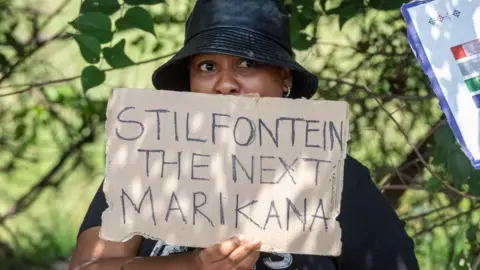 Getty Images
Getty ImagesThe government launched a crackdown on illegal mining in December 2023 under Operation Wala Umgodi (meaning “close the hole” in Isizulu).
Abandoned mines have been taken over by gangs, often led by ex-workers, who sell the finds on the black market.
People are forced into this illegal trade, either by force or by choice, and are made to spend months underground mining. The government says illegal mining will cost the South African economy $3.2bn (£2.6bn) in 2024 alone.
As part of the police operation, the entrances to various derelict mines were closed along with food and water supplies in an effort to eradicate illegal miners known locally as Zamas (which they took advantage of).
While Vala Umgodi has had much success in other provinces, the old Buffelsfontein gold mine presents a unique challenge.
Before the police operation, most miners were driven underground only by a makeshift pulley system operated by people on the surface.
But when security officials arrived in large numbers in August, they abandoned the mine and abandoned those inside the mine.
Community members then stepped in to help, using ropes to pull a few people, but it was a long, arduous process.
There were other difficult and dangerous exits and about 2,000 reappeared – most of them arrested and in police custody.
It is not clear why others did not leave – they may have been too weak or threatened by gang members in the mine – but they remained in desperate conditions.
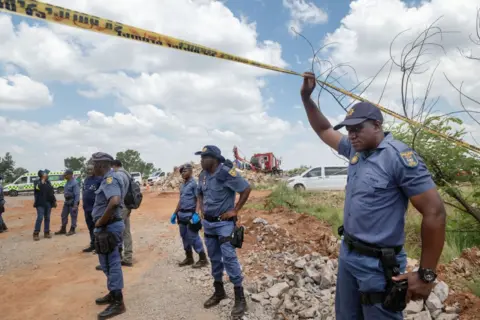 Getty Images
Getty ImagesOnly two of the 87 dead have been identified, police said on Thursday, adding that the fact that many were undocumented immigrants made the process difficult.
“We are of the view that the government has blood on its hands,” said Mine Affected Communities United in Action (Makua).
He argued that the miners were given no warning of what was about to happen before the police operation began.
In the past two months, Makua has been at the forefront of various court battles to force the government to first allow supplies and then undertake rescue operations.
His accusations against the government echo those of families who have previously said the authorities killed their relatives.
After the operation intensified, they took a hard line. In November, a minister, Kumbudzo Ntshavheni, made an embarrassing statement during a press conference that he was going to “smoke them out”.
The state did not allow anyone to help bring food down or bring in the miners, but only after several successful court applications was it allowed in.
In November, they made it down the shaft with a small amount of instant corn and water, but in court testimony one of the miners said it was not enough for the hundreds of people below, many of whom could not even chew or swallow. They.
More food was delivered in December, but again failed to sustain the men.
As the operation to remove the men and the bodies took only three days, it is difficult for Mr Mdebele to understand why this could not have been done sooner.
“This help is long overdue because we’re sorry for our government, to be honest.”
While the government has yet to officially respond to these allegations, the police have promised to continue clearing the country of decommissioned mines until May this year.
Speaking to reporters in Stilfontein on Tuesday, Mines Minister Gwede Mantashe was unapologetic. He said that the government will continue the fight against illegal mining, which is a crime and an “attack on the economy”.
On Thursday, Police Minister Senzo Macunu was a bit more conciliatory.
“I understand and accept that this is an emotional issue. Everyone wants to judge… but it would help us all as South African pathologists to wait until they have done their work,” he said.
The police defended their actions by saying that giving food to the miners was “allowing crime to flourish”.
It has been accused of promoting criminality in communities where illegal miners operate.
Several stories have been published in the local media linking the Zama Zama to various rapes and murders.
But for Mkwai, who put his own safety on the line to help the miners, people in the Stilfontein mines were trying to make a living.
“People risked their lives by climbing 2 kilometers down a rope to put food on the table for their families.”
He said he wanted the government to issue permits to artisans who were forced to enter the mines, which had been vacated due to South Africa’s high unemployment rate.
“If your kids are hungry, you don’t think twice about going down there because you have to feed them. You risk your life to put food on the table.”
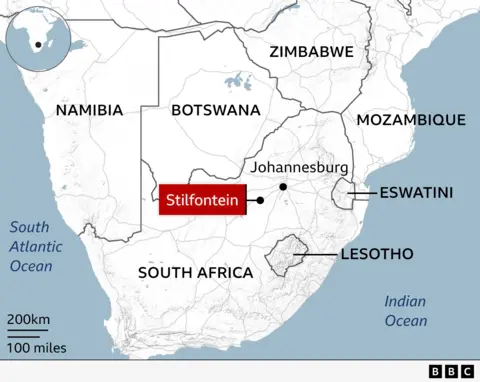
You may also be interested in:
 Getty Images/BBC
Getty Images/BBC







